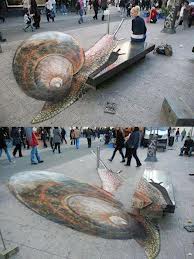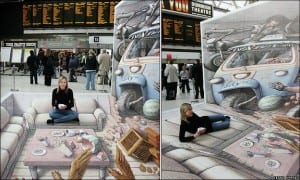Zizek: “How to Read Lacan”
4. Troubles With the Real: Lacan as a Viewer of Alien
Let’ start with some simple “word-math”:
Man + Omlet = Manlet
Or in Lacan’s world ‘lamella’, that mythical creature of pure surface and no volume, belonging to the realm of the un-dead, that does not exist but rather insists (on always being there, never going away), an organ that is not of the body even though it should have been and survives without it, like the grin of the Chesire Cat suspended in midair when the rest of the cat disappears.
In less mythican terms, Lacan associates it with what Feud referred to as the’partial object’ and its never-ending insistence is the libido, Freud’s ‘death drive’ that persists (insists!) on urging us to repeat painful previous experiences, as if ignoring all human limitations… Like Ridley Scotts Alien, it is indestructible, it is immortal and it can suck you in before you even realize what is happening! In all its monstrosity it resides in the realm of the Imaginary, just touching the limits of unrepresentable, representing the most terrifying imaginary dimension of the Real…
Imaginary———————–LAMELLA———————Real
Let us now explore Lacan’s take on the scientific mode of the Real and the relationship of the lamella with that… For Lacan, there is a scientific Real but we completely lack it, we are apart, it is too complex for us to fully perceive. The question then becomes:
What makes the real Real inaccessible to humans???
Is it the Imaginary with its illusions and misconceptions? NO!
Is it the Symbolic with its wall of language? NO!
Is it another Real??? YEEES!!!
It is the Real that for Lacan is at the core of human sexuality: the notion that “there is no sexual relationship” there is no mutual agreement, no common denominator and enjoyment only comes in comparison to a fundamental loss… We enjoy not because it is pure gain, but because it is ‘not loss’. The lamella then, baseon Freud characterization of this loss as ‘castration’, becomes the positive to the negative of castration, that which is left un-castrated when a living being enters the realm of sexual difference.
Taking into additional consideration Freud’s ‘latent thought’ expressed through his dream of Irma, we are caught between two “Reals”: that of the lamella, initiating from the Imaginary an image so horrific that it cancels imagery itself and the scientific Real, initiating from the Symbolic, an expression of nature’s automatic function. Lacan however adds a third Real, the je ne sais quoi or objet petit that goes beyond being the object of desire to being the cause of desire. Having said that, a new understanding of the word ‘melancolic’ as one “not mourning the loss of his object of desire but rather mourning the loss of his desire for the object he has come to posess”.
***
On a personal critical note I have to say here that expectations of what the object of our desire is and what it means to us lead us frequently to be disappointed in it when we finally acquire it, to become melancholic. And, as I recently replied to a comment on my previous post : “Fulfilling my desire IS potentially my truest nightmare because if my desire, my motivational force is accomplished what then is there left for me??? It is like Ithaca… It is the trip that matters not the destination, the process not the product… So if “all my life” I chase after a desire, if my actions, thoughts and feelings are driven or created by that desire, what is left for me when that desire is no longer there? What is left when I actually have it? My nightmare is that there will be nothing left! And then what?”
***
So now we can finally define the status of this object/cause of desire; it is that of an anamorphosis, something that can only be seen, let alone have meaning, only from a certain point of view, only when looked at form a certain angle. In the Lacanian universe (“wink-wink” J ) this is referred to as “object a” and is simply the “the inscription of the subject itself in the field of objects”, visible only when part of this field is anamorphically distorted by the subject’s desire.
Passing on from desire to shame (two concepts that actually go hand in hand considering how often desires are not expressed because we are ashamed to admit them!!!) we have the lamella as shame at its purest form, as an intruding organ that is not supposed to be inside my body and brings me face to face with all that is excess within me. SO then the Real becomes de-substantialized, is no longer something external but resides in the tiny cracks within the Symbolic network…As a result we have a reversal in causality where trauma is concerned, just like Einstein’s general theory of relativity reverses the state of causality provided by his special theory of relativity! Look for example at Freud’s “Wolf-man” and what that says about trauma: it is something that comes from outside and results in the disturbance of our psychic balance; but look now at what happens to that theory when later it is turned on its head: a symbolic deadend is reached within our psychic existence and to explain/resolve it an experience stored away in memory is recalled and labeled traumatic. As Lacan nicely sums it up the Real/the Thing is not the cause of inconsistencies in the Symbolic, but an effect of these inconsistencies. So even though natural objects know and automatically obey the laws of the Real, the same does not apply to humans as in their case laws may be forgotten or ignored…
***
Arriving thus to Heisenberg and his theory on quantum physics there seems to be and inconsistency between that theory and Einstein’s… That is however solved if we note that while one theory neatly applies to the microcosm (Heisenberg’s), the other just as neatly applies to the macrocosm (Einstein’s) and the theory of superstrings unites them sooo… PROBLEM SOLVED! It is the same with Lacan’s approach to linking Freud’s: he speaks of le sinthome as a micro-unit of enjoyment reconciling psychoanalysis with the natural sciences
So many links so little time!!!
Slavoj Žižek. On Melancholy. 2012
http://www.youtube.com/watch?v=FNXY-JY9I-M
Slavoj Žižek. Object a and The Function of Ideology. 2012
http://www.youtube.com/watch?v=Dq1F06J_HXo
Trauma Testimony Discourses/The Literary Sinthome as Testimonial of Trauma: The Case of(..)
http://www.youtube.com/watch?v=HStv6I3R8hU
The Milgram Obedience Experiment
http://psychology.about.com/od/historyofpsychology/a/milgram.htm –> Where the trauma lies…
And on a lighter note…
The Missing Piece
http://www.youtube.com/watch?v=4gEjCJOzqXc –> Melancholy,when we aquire the object of desire and it disapoints us… When we lose the desire…
RoadRunner Psychological Gravity
http://www.youtube.com/watch?v=OKZ3-IOlhIw –> when the natural laws of the Real meet Wile e Coyote…!
In the Artist’s World…
En Route Project – Sinthome (album preview)
http://www.youtube.com/watch?v=djTTGcaOgGQ –> Lacan inspires music!
3D street art! What we see from the right and what from the wrong angle… Anamorphosis 😉
One big question and a bunch of little ones…
What is it that keeps us attached to a place? What is it that makes us afraid to leave? Is it fear of not being able to come back? Is it the fear of losing all that we love in that place? OR is it actually the fear of losing the desire of wanting to come back, of losing the feelings we have that when we are in that place once we are far away for them to fade out? Andwhat is then in our best interest as evlolving human beings but also as artist?
This first set of questions has been bugging me for quite a while now, as to where I want to live and why that choice has proven to be so hard for me to make… I guess since ” I am an artist and my craft is calling” I’ll just go wherever that craft drags me!
On the other hand:
How can such fears and insecurities be expressed and dealt with through art?
Can the tools given to us by technology facilitate a more universal creative art life?
Is a contemporary artist’s responsibility to help hold on to the desire or to show ways of letting go and finding new ones?
Is it an artis’s job to create desire? –> DOESN’T HE ANYWAY IN A WAY??
Is it an artis’s job to play with the boundaries of the Real? –> BY ALL MEANS I BELIEVE IT IS…
I, as an artist, actually enjoy messing around with other people’s desires… I enjoy provoking them and making them question what they believe to be acceptably do-able or true… Even if I that is simply done by the faintest notion of subtext… I know I am not being very clear, but that’s perhaps the fun of it… When one is not clear, one can support any contradictory set of options, one can shift and change, one can adapt and never have to explain how or why, one can sipmly say “that was the plan all along” 😉

